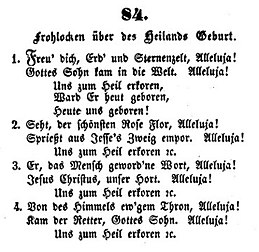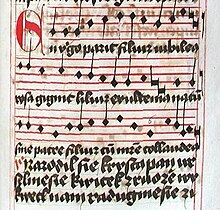| "Freu dich, Erd und Sternenzelt" | |
|---|---|
| German Christmas carol | |
 First print of the German lyrics, Leitmeritz 1844 First print of the German lyrics, Leitmeritz 1844 | |
| English | Be joyful, Earth and canopy of stars |
| Language | German |
| Based on | "Narodil se Kristus pán" |
| Published | 1844 (1844) |
| listen | |

"Freu dich, Erd und Sternenzelt" (Be joyful, Earth and canopy of stars) is a German Christmas carol. The text and melody are based on the Czech carol "Narodil se Kristus pán" (Lord Christ is born), which was derived around 1500 from a Latin model, "En Virgo parit filium", The Czech song is regarded as a popular Czech carol.
History
A German paraphrase in four stanzas with a refrain first appeared in 1844 in the collection by the Diocese of Leitmeritz, Katholische Gesänge für die öffentliche und häusliche Andacht, zunächst zum Gebrauche der Gläubigen der bischöflichen Leitmeritzer Diöcese, for congregational and personal devotion. The song was titled "Frohlocken über des Heilands Geburt" (Rejoicing about the Saviour's birth). The stanzas in seven lines differ only in their first and third lines, while the second and fourth is Halleluja, and the last stanzas are a refrain: "Uns zum Heil erkoren, ward er heut geboren, heute uns geboren." (For our salvation chosen, he was born today, today for us born). The song was included in regional parts of the first edition of the Catholic hymnal Gotteslob in 1975.
The Protestant minister Johannes Pröger in Gauersheim replaced around 1950 two of the stanzas (3 and 4) by lyrics referring to the Annunciation to the shepherds. This version has appeared in the Protestant hymnal Evangelisches Gesangbuch (as EG 47), in the list of ecumenical songs, and in various regional sections of the Gotteslob.
The simple and jolly melody has been varied several times. In the oldest document, it is in a triple metre. The song became a sacred folk song, due to its simple melody and repetitious refrain.
Melody

See also
References
- Das Graduale des Tschechischen Silber-Museums (in German) cantica.kh.cz
- ^ Parent, Ulrich (2000). Hahn, Gerhard (ed.). 47 Freu dich, Erd und Sternenzelt (in German). Vandenhoeck & Ruprecht. pp. 69–72. ISBN 978-3-52-550319-5.
{{cite book}}:|work=ignored (help) - "Narodil se Kristus pan | Radio Prag". radio.cz. 24 December 2004. Retrieved 2017-12-25.
- Hildesheim GL 813
- Grub, U. (2012). Evangelische Spuren im katholischen Einheitsgesangbuch "Gotteslob" von 1975. Lit. p. 235. ISBN 9783643116635. Retrieved 2017-12-25.
- Diocese of Hamburg Nr. 741
- "Moderner Rekonstruktionsversuch". cantica.kh.cz. Retrieved 2017-12-25.
- Czech version
External links
- Freu dich, Erd und Sternenzelt sung by the Windsbacher Knabenchor
- Narodil se Kristus pán, Radio Praha
- Josef Lauschman: Narodil se Kristus Pán Archived 2017-12-26 at the Wayback Machine. In: Cyril 1935, pp. 100–103
- Freu dich, Erd und Sternenzelt Christliche Liederdatenbank